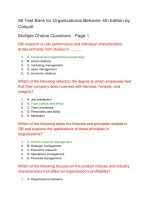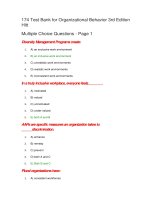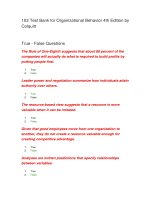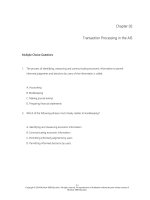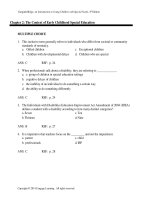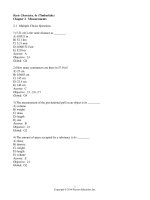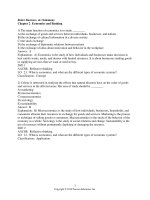Organizational behavior 4th edition hitt test bank
Bạn đang xem bản rút gọn của tài liệu. Xem và tải ngay bản đầy đủ của tài liệu tại đây (220.81 KB, 41 trang )
Test Bank
Chapter Two
True/False
Exploring Behavior in Action
1. The case study regarding the female firefighter at the Los Angeles Fire Department
resulted in discrimination.
Answer: True
Difficulty: Easy
AACSB Tier 1: Diversity
AACSB Tier 2: Group Dynamics
Blooms: Comprehension
LO1: Define organizational diversity.
The Strategic Importance of Organizational Diversity
2. A majority of human resource managers in Fortune 1000 companies said that the
successful management of diversity has a positive effect on corporate outcomes.
Answer: True
Difficulty: Easy
AACSB Tier 1: Diversity
AACSB Tier 2: HRM
Blooms: Comprehension
LO1: Define organizational diversity.
3. Many organizations have voluntarily adopted diversity management programs.
Answer: True
Difficulty: Medium
AACSB Tier 1: Diversity
AACSB Tier 2: HRM
Blooms: Knowledge
LO1: Define organizational diversity.
4. Harassment of various forms often leads to turnover and performance issues.
Answer: True
Difficulty: Medium
AACSB Tier 1: Diversity
AACSB Tier 2: Group Dynamics
Blooms: Comprehension
LO1: Define organizational diversity.
5. Diversity management programs can be aimed at recruiting and motivating highquality associates.
Answer: True
Difficulty: Medium
AACSB Tier 1: Diversity
AACSB Tier 2: HRM
Blooms: Comprehension
LO1: Define organizational diversity.
6. Most people feel more comfortable interacting and working with people who are
different to them on a variety of dimensions.
Answer: False
Difficulty: Easy
AACSB Tier 1: Diversity
AACSB Tier 2: Group Dynamics
Blooms: Comprehension
LO1: Define organizational diversity.
Diversity Defined
7. Diversity can be defined as a characteristic of one individual where the difference
exists on only one dimension.
Answer: False
Difficulty: Medium
AACSB Tier 1: Diversity
AACSB Tier 2: Group Dynamics
Blooms: Comprehension
LO1: Define organizational diversity.
8. Diversity is a group characteristic, not an individual characteristic.
Answer: True
Difficulty: Medium
AACSB Tier 1: Diversity
AACSB Tier 2: Group Dynamics
Blooms: Knowledge
LO1: Define organizational diversity.
9. Personality is considered a dimension of diversity.
Answer: True
Difficulty: Hard
AACSB Tier 1: Diversity
AACSB Tier 2: Individual Dynamics
Blooms: Knowledge
LO1: Define organizational diversity.
10.
Geographic background is not considered a dimension of diversity.
Answer: False
Difficulty: Hard
AACSB Tier 1: Diversity
AACSB Tier 2: Individual Dynamics
Blooms: Knowledge
LO1: Define organizational diversity.
11.
AAPs stand for Affirmative Action Programs.
Answer: True
Difficulty: Medium
AACSB Tier 1: Diversity
AACSB Tier 2: HRM
Blooms: Knowledge
LO1: Define organizational diversity.
12. In the U.S. federal contractors with 50 or more employees are not required to have
AAPs.
Answer: False
Difficulty: Hard
AACSB Tier 1: Diversity
AACSB Tier 2: Legal Responsibilities
Blooms: Knowledge
LO1: Define organizational diversity.
13. Important characteristics related to diversity include any characteristic that may
influence a person’s identity or the way in which he or she views the world.
Answer: True
Difficulty: Easy
AACSB Tier 1: Diversity
AACSB Tier 2: Individual Dynamics
Blooms: Comprehension
LO1: Define organizational diversity.
14. Affirmative Action Programs often require hiring quotas or lowered standards for
selection and promotion of women and minorities.
Answer: False
Difficulty: Easy
AACSB Tier 1: Diversity
AACSB Tier 2: Legal Responsibilities
Blooms: Knowledge
LO1: Define organizational diversity.
15. Google is an example of a monolithic organization.
Answer: False
Difficulty: Medium
AACSB Tier 1: Diversity
AACSB Tier 2: Environmental Influence
Blooms: Comprehension
LO1: Define organizational diversity.
16. Unintentional discrimination against individuals who have religious practices that
differ from those of the majority is most likely to occur in plural organizations.
Answer: True
Difficulty: Medium
AACSB Tier 1: Diversity
AACSB Tier 2: Group Dynamics
Blooms: Analysis
LO1: Define organizational diversity.
17. Diversity Management Programs apply to only some associates.
Answer: False
Difficulty: Medium
AACSB Tier 1: Diversity
AACSB Tier 2: HRM
Blooms: Comprehension
LO1: Define organizational diversity.
18. Diversity Management Programs attempt to uncover the root causes of diversity
problems.
Answer: True
Difficulty: Medium
AACSB Tier 1: Diversity
AACSB Tier 2: HRM
Blooms: Knowledge
LO1: Define organizational diversity.
19. Diversity Management Programs are only temporary programs.
Answer: False
Difficulty: Medium
AACSB Tier 1: Diversity
AACSB Tier 2: HRM
Blooms: Knowledge
LO1: Define organizational diversity.
20. Diversity Management Programs create an inclusive work environment.
Answer: True
Difficulty: Easy
AACSB Tier 1: Diversity
AACSB Tier 2: HRM
Blooms: Comprehension
LO1: Define organizational diversity.
21. The purpose of Diversity Management Programs is to allow all associates to reach
their full potential.
Answer: True
Difficulty: Medium
AACSB Tier 1: Diversity
AACSB Tier 2: HRM
Blooms: Knowledge
LO1: Define organizational diversity.
22. AAPs focus on recruitment, mobility and retention of employees.
Answer: True
Difficulty: Medium
AACSB Tier 1: Diversity
AACSB Tier 2: HRM
Blooms: Knowledge
LO1: Define organizational diversity.
23. AAPs are ongoing and create permanent changes.
Answer: False
Difficulty: Medium
AACSB Tier 1: Diversity
AACSB Tier 2: HRM
Blooms: Knowledge
LO1: Define organizational diversity.
24. AAPs do not address the cause of discrimination problems.
Answer: True
Difficulty: Hard
AACSB Tier 1: Diversity
AACSB Tier 2: HRM
Blooms: Knowledge
LO1: Define organizational diversity.
25. AAPs assume individuals will individually assimilate into the organization.
Answer: True
Difficulty: Medium
AACSB Tier 1: Diversity
AACSB Tier 2: HRM
Blooms: Knowledge
LO1: Define organizational diversity.
26. A multicultural organization fosters and values differences.
Answer: True
Difficulty: Easy
AACSB Tier 1: Diversity
AACSB Tier 2: Environmental Influence
Blooms: Knowledge
LO1: Define organizational diversity.
27. Most organizations in the U.S. are multicultural organizations.
Answer: False
Difficulty: Medium
AACSB Tier 1: Diversity
AACSB Tier 2: Environmental Influence
Blooms: Comprehension
LO1: Define organizational diversity.
28. Plural organizations have diverse workforces.
Answer: True
Difficulty: Medium
AACSB Tier 1: Diversity
AACSB Tier 2: Environmental Influence
Blooms: Knowledge
LO1: Define organizational diversity.
29. Plural organizations do not take steps to be inclusive.
Answer: False
Difficulty: Medium
AACSB Tier 1: Diversity
AACSB Tier 2: Environmental Influence
Blooms: Comprehension
LO1: Define organizational diversity.
30. Plural organizations foster and value diversity.
Answer: False
Difficulty: Medium
AACSB Tier 1: Diversity
AACSB Tier 2: Environmental Influence
Blooms: Comprehension
LO1: Define organizational diversity.
31. Plural organizations tolerate diversity and do not foster or value it.
Answer: True
Difficulty: Hard
AACSB Tier 1: Diversity
AACSB Tier 2: Environmental Influence
Blooms: Comprehension
LO1: Define organizational diversity.
32. Monolithic organizations are homogeneous.
Answer: True
Difficulty: Easy
AACSB Tier 1: Diversity
AACSB Tier 2: Environmental Influence
Blooms: Knowledge
LO1: Define organizational diversity.
33. Monolithic organizations tend to have extreme occupational segregation.
Answer: True
Difficulty: Medium
AACSB Tier 1: Diversity
AACSB Tier 2: Environmental Influence
Blooms: Knowledge
LO1: Define organizational diversity.
Forces of Change
34. Over the past ten years more than 75% of people entering the U.S. workforce have
been members of racial or ethnic minority groups.
Answer: False
Difficulty: Hard
AACSB Tier 1: Diversity
AACSB Tier 2: Environmental Influence
Blooms: Comprehension
LO2: Understand the forces driving a more diverse workforce and the need for diversity
management.
35. The proportion of racial and ethnic minorities entering the U.S. workforce is
expected to increase indefinitely.
Answer: True
Difficulty: Medium
AACSB Tier 1: Diversity
AACSB Tier 2: Environmental Influence
Blooms: Knowledge
LO2: Understand the forces driving a more diverse workforce and the need for diversity
management.
36. The U.S. Bureau of Labor Statistics has predicted that the number of service
producing jobs will grow by approximately 12 percent between 2012 and 2022.
Answer: True
Difficulty: Hard
AACSB Tier 1: Diversity
AACSB Tier 2: Environmental Influence
Blooms: Comprehension
LO2: Understand the forces driving a more diverse workforce and the need for diversity
management.
37. As globalization increases, the need for successful diversity management decreases.
Answer: False
Difficulty: Medium
AACSB Tier 1: Diversity
AACSB Tier 2: HRM
Blooms: Comprehension
LO2: Understand the forces driving a more diverse workforce and the need for diversity
management.
38. Having diverse teams may allow for synergistic effects.
Answer: True
Difficulty: Medium
AACSB Tier 1: Diversity
AACSB Tier 2: Group Dynamics
Blooms: Knowledge
LO2: Understand the forces driving a more diverse workforce and the need for diversity
management.
39. The percentage of people from racial and ethnic minorities entering the workforce is
expected to remain stable for the next decade.
Answer: False
Difficulty: Hard
AACSB Tier 1: Diversity
AACSB Tier 2: Environmental Influence
Blooms: Comprehension
LO2: Understand the forces driving a more diverse workforce and the need for diversity
management.
40. In the next decade, the percentage of women entering the workforce is likely to be
greater than the percentage of men.
Answer: True
Difficulty: Medium
AACSB Tier 1: Diversity
AACSB Tier 2: Environmental Influence
Blooms: Comprehension
LO2: Understand the forces driving a more diverse workforce and the need for diversity
management.
41. The retirement of members of the baby boom generation is expected to cause a major
U.S. labor shortage in the next twenty years.
Answer: True
Difficulty: Easy
AACSB Tier 1: Diversity
AACSB Tier 2: Environmental Influence
LO2: Understand the forces driving a more diverse workforce and the need for diversity
management.
42. By the year 2050 one in every five Americans will be 65 years old or younger.
Answer: False
Difficulty: Medium
AACSB Tier 1: Diversity
AACSB Tier 2: Environmental Influence
Blooms: Knowledge
LO2: Understand the forces driving a more diverse workforce and the need for diversity
management.
43. A service economy depends on effective interactions between clients and service
providers and, with changing demographics, both groups are becoming more diverse.
Therefore, the change toward a service-based economy increases the need for effective
diversity management.
Answer: True
Difficulty: Hard
AACSB Tier 1: Diversity
AACSB Tier 2: HRM
Blooms: Analysis
LO2: Understand the forces driving a more diverse workforce and the need for diversity
management.
Diversity Management and High-Involvement Organizations
44. Increasing the diversity of a work group decreases the number of problems the group
is likely to have.
Answer: False
Difficulty: Medium
AACSB Tier 1: Diversity
AACSB Tier 2: Group Dynamics
Blooms: Comprehension
LO3: Understand the role of successfully managing diversity as a part of high
involvement management practices and the associated outcomes for individuals, groups,
organizations, and society.
45. Research indicates that by simply increasing the demographic diversity among its
associates, an organization is likely to also increase its profits.
Answer: False
Difficulty: Medium
AACSB Tier 1: Diversity
AACSB Tier 2: Group Dynamics
Blooms: Comprehension
LO3: Understand the role of successfully managing diversity as a part of high
involvement management practices and the associated outcomes for individuals, groups,
organizations, and society.
46. Companies that have a reputation for a sensitive and caring culture that embraces
diversity are likely to attract more applicants, thus increasing the likelihood of hiring
more talented associates.
Answer: True
Difficulty: Hard
AACSB Tier 1: Diversity
AACSB Tier 2: Environmental Influence
Blooms: Comprehension
LO3: Understand the role of successfully managing diversity as a part of high
involvement management practices and the associated outcomes for individuals, groups,
organizations, and society.
47. A high-involvement work environment can only be achieved if diversity is valued and
successfully managed.
Answer: True
Difficulty: Easy
AACSB Tier 1: Diversity
AACSB Tier 2: Ethical Responsibilities
Blooms: Comprehension
LO3: Understand the role of successfully managing diversity as a part of high
involvement management practices and the associated outcomes for individuals, groups,
organizations, and society.
48. Fault lines occur when two or more dimensions of diversity are correlated.
Answer: True
Difficulty: Easy
AACSB Tier 1: Diversity
AACSB Tier 2: Group Dynamics
Blooms: Knowledge
LO3: Understand the role of successfully managing diversity as a part of high
involvement management practices and the associated outcomes for individuals, groups,
organizations, and society.
49. Diversity alone guarantees good corporate performance.
Answer: False
Difficulty: Medium
AACSB Tier 1: Diversity
AACSB Tier 2: Environmental Influence
Blooms: Comprehension
LO3: Understand the role of successfully managing diversity as a part of high
involvement management practices and the associated outcomes for individuals, groups,
organizations, and society.
50. Title VII of the 1964 Civil Rights Act prohibits organizations from discriminating
against individuals on the basis of race, color, religion, sex, or national origin.
Answer: True
Difficulty: Easy
AACSB Tier 1: Diversity
AACSB Tier 2: Ethical Responsibilities
Blooms: Knowledge
LO3: Understand the role of successfully managing diversity as a part of high
involvement management practices and the associated outcomes for individuals, groups,
organizations, and society.
51. The Age Discrimination in Employment Act of 1967 prohibits organizations from
discriminating against individuals over the age of 55.
Answer: False
Difficulty: Easy
AACSB Tier 1: Diversity
AACSB Tier 2: Legal Responsibilities
Blooms: Knowledge
LO3: Understand the role of successfully managing diversity as a part of high
involvement management practices and the associated outcomes for individuals, groups,
organizations, and society.
52. Negative publicity from discrimination lawsuits tends to have no effect on a
company’s stock price.
Answer: False
Difficulty: Medium
AACSB Tier 1: Diversity
AACSB Tier 2: Creation of Value
Blooms: Comprehension
LO3: Understand the role of successfully managing diversity as a part of high
involvement management practices and the associated outcomes for individuals, groups,
organizations, and society.
53. The diversity found in the Obama administration reflects the diversity found in
corporate America.
Answer: False
Difficulty: Hard
AACSB Tier 1: Diversity
AACSB Tier 2: Individual Dynamics
Blooms: Comprehension
LO3: Understand the role of successfully managing diversity as a part of high
involvement management practices and the associated outcomes for individuals, groups,
organizations, and society.
Roadblocks to Diversity
54. Modern racism occurs because of deep-seated, unconscious prejudice in people who
believe that racism is wrong.
Answer: True
Difficulty: Medium
AACSB Tier 1: Diversity
AACSB Tier 2: Individual Dynamics
Blooms: Comprehension
LO4: Discuss the various roadblocks to effectively managing a diverse workforce.
55. Stereotyping is valuable in improving interpersonal relations because it allows us to
simplify information about other people.
Answer: False
Difficulty: Easy
AACSB Tier 1: Diversity
AACSB Tier 2: Environmental Influence
Blooms: Comprehension
LO4: Discuss the various roadblocks to effectively managing a diverse workforce.
56. Employees whose social identity is different from the majority in their workplace are
likely to feel pressured to behave in ways that are unnatural for them.
Answer: True
Difficulty: Easy
AACSB Tier 1: Diversity
AACSB Tier 2: Group Dynamics
Blooms: Comprehension
LO4: Discuss the various roadblocks to effectively managing a diverse workforce.
57. Social identity “in-group” and “out-group” dynamics are likely to enhance successful
diversity management.
Answer: False
Difficulty: Easy
AACSB Tier 1: Diversity
AACSB Tier 2: Group Dynamics
Blooms: Comprehension
LO4: Discuss the various roadblocks to effectively managing a diverse workforce.
58. Status and power that is assigned by cultural norms and dependent on group
membership is referred to as ascribed status.
Answer: True
Difficulty: Easy
AACSB Tier 1: Diversity
AACSB Tier 2: Group Dynamics
Blooms: Knowledge
LO4: Discuss the various roadblocks to effectively managing a diverse workforce.
59. Power differentials based on ascribed status improve an organization’s ability to
develop an inclusive workplace environment.
Answer: False
Difficulty: Medium
AACSB Tier 1: Diversity
AACSB Tier 2: Group Dynamics
Blooms: Comprehension
LO4: Discuss the various roadblocks to effectively managing a diverse workforce.
60. Lack of skills is a frequently cited reason for the lack of integration of women and
minorities in organizations.
Answer: True
Difficulty: Medium
AACSB Tier 1: Diversity
AACSB Tier 2: HRM
Blooms: Comprehension
LO4: Discuss the various roadblocks to effectively managing a diverse workforce.
61. Differences in communication preferences are seldom a roadblock to establishing an
effective diversity environment.
Answer: False
Difficulty: Hard
AACSB Tier 1: Diversity
AACSB Tier 2: Group Dynamics
Blooms: Analysis
LO4: Discuss the various roadblocks to effectively managing a diverse workforce.
62. Cassandra, a lower level manager discovers theft in her department. When reporting
the incident to her supervisor, she confides, “I know who is doing this, but I must
interview everyone so no one will think I am prejudiced.” Cassandra is engaging in
discrimination.
Answer: False
Difficulty: Hard
AACSB Tier 1: Diversity
AACSB Tier 2: Ethical Responsibilities
Blooms: Analysis, Application
LO4: Discuss the various roadblocks to effectively managing a diverse workforce.
63. Our stereotypes lead us to believe that we have more factual information about an
individual or group than we have in reality.
Answer: True
Difficulty: Medium
AACSB Tier 1: Diversity
AACSB Tier 2: Individual Dynamics
Blooms: Analysis
LO4: Discuss the various roadblocks to effectively managing a diverse workforce.
Effectively Creating and Managing Diversity
64. In successful diversity management programs, managers at all levels are held
accountable for implementing diversity initiatives.
Answer: True
Difficulty: Easy
AACSB Tier 1: Diversity
AACSB Tier 2: HRM
Blooms: Knowledge
LO5: Describe how organizations and individuals can create and effectively manage
diversity.
65. The actions of associates in supporting diversity are more important than the actions
of managers because associates establish the working climate of the organization.
Answer: False
Difficulty: Medium
AACSB Tier 1: Diversity
AACSB Tier 2: Group Dynamics
Blooms: Comprehension
LO5: Describe how organizations and individuals can create and effectively manage
diversity.
66. Diversity programs should be designed to meet the needs of disadvantaged groups
within an organization.
Answer: False
Difficulty: Hard
AACSB Tier 1: Diversity
AACSB Tier 2: HRM
Blooms: Analysis
LO5: Describe how organizations and individuals can create and effectively manage
diversity.
67. Affinity groups are groups that share common interests.
Answer: True
Difficulty: Easy
AACSB Tier 1: Diversity
AACSB Tier 2: Group Dynamics
Blooms: Knowledge
LO5: Describe how organizations and individuals can create and effectively manage
diversity.
68. Affinity groups are also good sources of feedback about the effectiveness of
diversity initiatives.
Answer: True
Difficulty: Medium
AACSB Tier 1: Diversity
AACSB Tier 2: Group Dynamics
Blooms: Knowledge
LO5: Describe how organizations and individuals can create and effectively manage
diversity.
69. To create a truly inclusive environment, diversity programs need to teach people
how to tolerate diversity.
Answer: False
Difficulty: Medium
AACSB Tier 1: Diversity
AACSB Tier 2: HRM
Blooms: Comprehension
LO5: Describe how organizations and individuals can create and effectively manage
diversity.
Short Answer
The Strategic Importance of Organizational Diversity
70. Many individuals feel most comfortable interacting and working with people who are
______ to them on a variety of dimensions.
Answer: similar
Difficulty: Medium
AACSB Tier 1: Diversity
AACSB Tier 2: Group Dynamics
Blooms: Knowledge
LO1: Define organizational diversity.
71. Diversity, effectively managed, can help an organization better understand and serve
all its customers, attract more customers, and become better problem solvers. These
positive effects of diversity help organizations build ___________.
Answer: a competitive advantage
Difficulty: Medium
AACSB Tier 1: Diversity
AACSB Tier 2: HRM
Blooms: Analysis
LO1: Define organizational diversity.
Diversity Defined
72. Diversity can be defined as a characteristic of a group of people where differences
exist on or more relevant _______, such as gender.
Answer: dimensions
Difficulty: Easy
AACSB Tier 1: Diversity
AACSB Tier 2: Individual Dynamics
Blooms: Knowledge
LO1: Define organizational diversity.
73. The key idea behind an affirmative action program (AAP) is to ensure fair _____ of
women and racial and ethnic minorities in the workplace.
Answer: representation
Difficulty: Medium
AACSB Tier 1: Diversity
AACSB Tier 2: HRM
Blooms: Knowledge
LO1: Define organizational diversity.
74. The goal of diversity management programs is to improve organizational _______.
Answer: performance
Difficulty: Medium
AACSB Tier 1: Diversity
AACSB Tier 2: HRM
Blooms: Knowledge
LO1: Define organizational diversity.
75. Organizations using a strategic approach in managing diversity, train their managers
to build ______ work environments.
Answer: inclusive
Difficulty: Medium
AACSB Tier 1: Diversity
AACSB Tier 2: Strategy
Blooms: Analysis
LO1: Define organizational diversity.
76. The law that protects individuals who are qualified and have a disability is _______.
Answer: Title I of the Americans with Disabilities Act of 1990
Difficulty: Easy
AACSB Tier 1: Diversity
AACSB Tier 2: Legal Responsibilities
Blooms: Knowledge
LO3: Understand the role of successfully managing diversity as a part of high
involvement management practices and the associated outcomes for individuals, groups,
organizations, and society.
77. Google is an example of a(n) ______ organization because its organizational culture
fosters and values differences.
Answer: multicultural
Difficulty: Medium
AACSB Tier 1: Diversity
AACSB Tier 2: Environmental Influence
Blooms: Comprehension
LO1: Define organizational diversity.
78. A(n) ________ organization is demographically and culturally homogeneous. These
organizations actively discourage diversity.
Answer: monolithic
Difficulty: Easy
AACSB Tier 1: Diversity
AACSB Tier 2: Environmental Influence
Blooms: Knowledge
LO1: Define organizational diversity.
79. _______ organizations have diverse workforces and take steps to be inclusive and
respectful of people from different cultural backgrounds. Diversity is tolerated but not
fostered.
Answer: Plural
Difficulty: Easy
AACSB Tier 1: Diversity
AACSB Tier 2: Environmental Influence
Blooms: Knowledge
LO1: Define organizational diversity.
Forces of Change
80. Which of the forces of change is most responsible for the increasing rate at which
U.S. employees working outside the U.S. must develop skills in working effectively with
people who speak different languages? ______________
Answer: Globalization Difficulty: Easy
AACSB Tier 1: Diversity
AACSB Tier 2: Environmental Influence
Blooms: Comprehension
LO2: Understand the forces driving a more diverse workforce and the need for diversity
management.
Diversity Management and High-Involvement Organizations
81. A middle manager implements work teams as a way of improving the quality of
performance among workers. However, the diversity of the workforce leads to negative
interactions within the teams. Name two methods the manager could use to facilitate the
positive effects of team diversity and reduce the negative effects. ____________ and
__________
Answer: group identity; group goals Difficulty: Medium
AACSB Tier 1: Diversity
AACSB Tier 2: Group Dynamics
Blooms: Analysis, Application
LO3: Understand the role of successfully managing diversity as a part of high
involvement management practices and the associated outcomes for individuals, groups,
organizations, and society.
82. Research has shown that increasing the demographic diversity at the ______ levels of
the organization is likely to improve its bottom-line performance.
Answer: top or higher or highest
Difficulty: Medium
AACSB Tier 1: Diversity
AACSB Tier 2: Strategy
Blooms: Analysis
LO3: Understand the role of successfully managing diversity as a part of high
involvement management practices and the associated outcomes for individuals, groups,
organizations, and society.
83. Belief in principles of kindness and justice are __________ reasons for fostering
diversity.
Answer: moral
Difficulty: Hard
AACSB Tier 1: Diversity
AACSB Tier 2: Ethical Responsibilities
Blooms: Analysis
LO3: Understand the role of successfully managing diversity as a part of high
involvement management practices and the associated outcomes for individuals, groups,
organizations, and society.
84. Name three negative effects that firms are likely to experience as a result of having
lawsuits for discrimination filed against them. __________, _________, and ________.
Answer: any three of the following: legal costs, bad publicity, boycotts, fewer job
applicants, lower stock prices
Difficulty: Medium
AACSB Tier 1: Diversity
AACSB Tier 2: Ethical Responsibilities
Blooms: Comprehension
LO3: Understand the role of successfully managing diversity as a part of high
involvement management practices and the associated outcomes for individuals, groups,
organizations, and society.
85. A recent study of Fortune 500 firms found that companies with the highest
representation of ________ in top positions strongly outperformed companies with the
lowest representation of (same answer) in top positions.
Answer: women
Difficulty: Easy
AACSB Tier 1: Diversity
AACSB Tier 2: Creation of Value
Blooms: Knowledge
LO3: Understand the role of successfully managing diversity as a part of high
involvement management practices and the associated outcomes for individuals, groups,
organizations, and society.
Roadblocks to Diversity
86. Marjorie prefers that people of a certain cultural group are not included in her social
circle. Marjorie’s attitude is an example of ______.
Answer: prejudice
Difficulty: Medium
AACSB Tier 1: Diversity
AACSB Tier 2: Individual Dynamics
Blooms: Analysis, Application
LO4: Discuss the various roadblocks to effectively managing a diverse workforce.
87. Abbey believes that members of a certain ethnic group are more intelligent than
members of other groups. Abbey’s belief is an example of _______.
Answer: stereotyping Difficulty: Medium
AACSB Tier 1: Diversity
AACSB Tier 2: Individual Dynamics
Blooms: Analysis, Application
LO4: Discuss the various roadblocks to effectively managing a diverse workforce.
88. Status and power that is assigned by cultural norms and depends on the group to
which one belongs is known as __________.
Answer: ascribed status
Difficulty: Easy
AACSB Tier 1: Diversity
AACSB Tier 2: Group Dynamics
Blooms: Comprehension
LO4: Discuss the various roadblocks to effectively managing a diverse workforce.
89. Kenyatta is very proud of the fact that she is a Black woman. She becomes angry if
someone, especially another Black woman, makes a derogatory remark about people of
her race. Kenyatta has a strong ______.
Answer: social identity
Difficulty: Medium
AACSB Tier 1: Diversity
AACSB Tier 2: Individual Dynamics
Blooms: Analysis, Application
LO4: Discuss the various roadblocks to effectively managing a diverse workforce.
90. Name two common differences among the members of ethnically diverse groups that
are likely to cause communication problems. ________ and _______.
Answer: language; cultural norms
Difficulty: Easy
AACSB Tier 1: Diversity, Communication
AACSB Tier 2: Group Dynamics
Blooms: Knowledge
LO4: Discuss the various roadblocks to effectively managing a diverse workforce.
91. A retail store recently posted a sign at each cash register that reminded clerks to “Be
especially watchful of individuals from South America as they are most likely to be
shoplifters.” This is an example of __________.
Answer: prejudice or stereotyping
Difficulty: Medium
AACSB Tier 1: Diversity
AACSB Tier 2: Group Dynamics
Blooms: Analysis, Application
LO4: Discuss the various roadblocks to effectively managing a diverse workforce.
Effectively Creating and Managing Diversity
92. Common measures of diversity effectiveness focus on _____ rewards.
Answer: external
Difficulty: Medium
AACSB Tier 1: Diversity
AACSB Tier 2: Strategy
Blooms: Knowledge
LO5: Describe how organizations and individuals can create and effectively manage
diversity.
93. In creating and implementing a successful diversity management program, it is
important for leaders to communicate a(n) ______ that recognizes the importance of
diversity to the organization.
Answer: vision
Difficulty: Medium
AACSB Tier 1: Diversity
AACSB Tier 2: Strategy
Blooms: Comprehension
LO5: Describe how organizations and individuals can create and effectively manage
diversity.
94. For a diversity management program to be successful, it must be linked to the
organization’s ________.
Answer: strategic plan
Difficulty: Easy
AACSB Tier 1: Diversity
AACSB Tier 2: Strategy
Blooms: Knowledge
LO5: Describe how organizations and individuals can create and effectively manage
diversity.
95. A good way to increase the level of associate involvement in diversity programs is
through the use of _____ groups whose members share common interests and can serve
as a communication mechanism between associates and managers.
Answer: affinity
Difficulty: Medium
AACSB Tier 1: Diversity
AACSB Tier 2: Group Dynamics
Blooms: Comprehension
LO5: Describe how organizations and individuals can create and effectively manage
diversity.
96. Managers at ______ levels are held accountable for advancing diversity initiatives.
Answer: All
Difficulty: Easy
AACSB Tier 1: Diversity
AACSB Tier 2: Strategy
Blooms: Knowledge
LO5: Describe how organizations and individuals can create and effectively manage
diversity.
97. The second criterion for effective diversity management requires that diversity be
linked to the organization’s_________.
Answer: Strategic Plan Difficulty: Easy
AACSB Tier 1: Diversity
AACSB Tier 2: Strategy
Blooms: Knowledge
LO5: Describe how organizations and individuals can create and effectively manage
diversity.
98. High-ranking leaders send relevant communications through ______ channels when
effectively managing diversity.
Answer: multiple
Difficultly: Medium
AACSB Tier 1: Diversity
AACSB Tier 2: Strategy
Blooms: Knowledge
LO5: Describe how organizations and individuals can create and effectively manage
diversity.
Multiple Choice
The Strategic Importance of Organizational Diversity
99. Many organizations have _________ diversity management programs.
A) been forced to adopt
B) voluntarily adopted
C) scorned
D) turned their back on
E) both been forced to adopt and scorned
Answer: B
Difficulty: Easy
AACSB Tier 1: Diversity
AACSB Tier 2: Ethical Responsibilities
Blooms: Knowledge
LO1: Define organizational diversity.
100. ________of human resource managers at Fortune 1000 companies said they
believed that successfully managing diversity improves their organizations.
A) 10 percent
B) 20 percent
C) 25 percent
D) Under 25 percent
E) Over 79 percent
Answer: E
Difficulty: Easy
AACSB Tier 1: Diversity
AACSB Tier 2: HRM
Blooms: Knowledge
LO1: Define organizational diversity.
101. Many individuals feel most comfortable interacting and working with people who
are ______ on a variety of dimensions.
A) truthful
B) pleasant
C) intelligent
D) similar to them
E) dissimilar to them
Answer: D
Difficulty: Medium
AACSB Tier 1: Diversity
AACSB Tier 2: Individual Dynamics
Blooms: Knowledge
LO1: Define organizational diversity.
102. In a truly inclusive workplace, everyone feels________.
A) motivated
B) valued
C) unmotivated
D) under-valued
E)both motivated and valued
Answer: E
Difficulty: Easy
AACSB Tier 1: Diversity
AACSB Tier 2: Motivation Concepts
Blooms: Knowledge
LO1: Define organizational diversity.
Diversity Defined
103. _________ can be defined as a characteristic of a group where differences exist on
one or more relevant dimensions.
A) Orientation
B) Diversity
C) Inter-personal differences
D) Intra-personal differences
E) Intra-group differences
Answer: B
Difficulty: Easy
AACSB Tier 1: Diversity
AACSB Tier 2: Group Dynamics
Blooms: Knowledge
LO1: Define organizational diversity.
104. Diversity is a(n) ______ characteristic.
A) general
B) specific
C) group
D) individual
E) orientation
Answer: C
Difficulty: Hard
AACSB Tier 1: Diversity
AACSB Tier 2: Group Dynamics
Blooms: Knowledge
LO1: Define organizational diversity.
105. In practice, diversity is often defined in terms of _________ dimensions.
A) particular
B) general
C) whole
D) temporary
E) none of these
Answer: A
Difficulty: Medium
AACSB Tier 1: Diversity
AACSB Tier 2: Group Dynamics
Blooms: Knowledge
LO1: Define organizational diversity.
106. The most common dimension(s) of diversity is/are
A) gender
B) race
C) ethnicity
D) age
E) all of these
Answer: E
Difficulty: Easy
AACSB Tier 1: Diversity
AACSB Tier 2: Group Dynamics
Blooms: Knowledge
LO1: Define organizational diversity.
107. All of the following are dimensions of diversity except:
A) social class
B) age
C) geographical background
D) personality
E) all of these are dimensions of diversity
Answer: E
Difficulty: Hard
AACSB Tier 1: Diversity
AACSB Tier 2: Group Dynamics
Blooms: Knowledge
LO1: Define organizational diversity.
108. AAPs represents:
A) American Association of Programs
B) Associated Action Programs
C) Affirmative Action Programs
D) Affirmative Association Programs
E) None of these
Answer: C
Difficulty: Easy
AACSB Tier 1: Diversity
AACSB Tier 2: HRM
Blooms: Knowledge
LO1: Define organizational diversity.
109. AAPs are specific measures an organization takes to ______ discrimination.
A) enhance
B) remedy
C) prevent
D)Both enhance and prevent
E)Both remedy and prevent
Answer: E
Difficulty: Medium
AACSB Tier 1: Diversity
AACSB Tier 2: HRM
Blooms: Knowledge
LO1: Define organizational diversity.
110. In the United States, federal contractors with 50 or more employees and government
contracts of $50,000 or more _________ AAPs.
A) can opt to have
B) can voluntarily to decide to have
C) are required to have
D) are not required to have
E) none of these
Answer: C
Difficulty: Medium
AACSB Tier 1: Diversity
AACSB Tier 2: Legal Responsibilities
Blooms: Knowledge
LO1: Define organizational diversity.
111. A central feature of an AAP is
A) a utilization analysis.
B) an unspecific target.
C) a hiring quota.
D) an implemented target program.
E) a rationale analysis
Answer: A
Difficulty: Hard
AACSB Tier 1: Diversity
AACSB Tier 2: HRM
Blooms: Comprehension
LO1: Define organizational diversity.
112. AAPs usually provide ______ action/changes.
A) long-term
B) sustainable
C) temporary
D) fixed
E) concrete
Answer: C
Difficulty: Medium
AACSB Tier 1: Diversity
AACSB Tier 2: HRM
Blooms: Knowledge
LO1: Define organizational diversity.
113. Diversity Management Programs:
A) target some associates
B) target some of the more prominent associates
C) target all associates
D) target the seasoned associates
E) target the underrepresented associates
Answer: C
Difficulty: Medium
AACSB Tier 1: Diversity
AACSB Tier 2: HRM
Blooms: Knowledge
LO1: Define organizational diversity.
114. Diversity Management Programs:
A) have on-going timeframes.
B) have temporary timeframes.
C) have timeframes that are in flux
D) have timeframes that are inconsistent
E) have timeframes that vary
Answer: A
Difficulty: Medium
AACSB Tier 1: Diversity
AACSB Tier 2: HRM
Blooms: Knowledge
LO1: Define organizational diversity.
115. Diversity Management Programs:
A) attempt to uncover the root causes of diversity problems.
B) do not attempt to uncover the root causes of diversity problems.
C) can sometimes uncover the root causes of diversity problems.
D) are not aimed at uncovering the root causes of diversity problems
E) are not relevant to diversity root causes.
Answer: A
Difficultly: Medium
AACSB Tier 1: Diversity
AACSB Tier 2: HRM
Blooms: Knowledge
LO1: Define organizational diversity.
116. Diversity Management Programs:
A) do not assume the organization will change
B) do not assume that the managers will change
C) assume that the organization will change
D) assume that the managers will change
E)Both assume that the organization will change and assume that the managers will
change are correct
Answer: E
Difficulty: Medium
AACSB Tier 1: Diversity
AACSB Tier 2: HRM
Blooms: Comprehension
LO1: Define organizational diversity.
117. Diversity Management Programs create an environment where:
A) all associates will be stifled
B) all associates are allowed to reach their full potential
C) all associates’ growth will be compromised
D) all associates can choose to grow
E) none of these
Answer: B
Difficulty: Easy
AACSB Tier 1: Diversity
AACSB Tier 2: HRM
Blooms: Knowledge
LO1: Define organizational diversity.
118. Diversity Management Programs create:
A) an exclusive work environment
B) an inclusive work environment
C) unrealistic work environments
D) realistic work environments
E) inconsistent work environments
Answer: B
Difficulty: Medium
AACSB Tier 1: Diversity
AACSB Tier 2: HRM
Blooms: Comprehension
LO1: Define organizational diversity.
119. Affirmative Action Programs focus on:
A) mobility
B) retention
C) recruitment
D) mobility, retention and recruitment are correct
E) None of these
Answer: D
Difficulty: Easy
AACSB Tier 1: Diversity
AACSB Tier 2: HRM
Blooms: Knowledge
LO1: Define organizational diversity.
120. Affirmative Action Programs:
A) do not address the cause of problems.
B) address the cause of problems
C) look in detail at the causes of diversity problems
D) are inconsistent in addressing the cause of problems
E) none of these
Answer: A
Difficulty: Medium
AACSB Tier 1: Diversity
AACSB Tier 2: HRM
Blooms: Knowledge
LO1: Define organizational diversity.
121. Affirmative Action Programs:
A) target women
B) target people with disabilities
C) target ethnic minorities
D) target racial minorities
E) All of these
Answer: E
Difficulty: Easy
AACSB Tier 1: Diversity
AACSB Tier 2: Individual Dynamics

